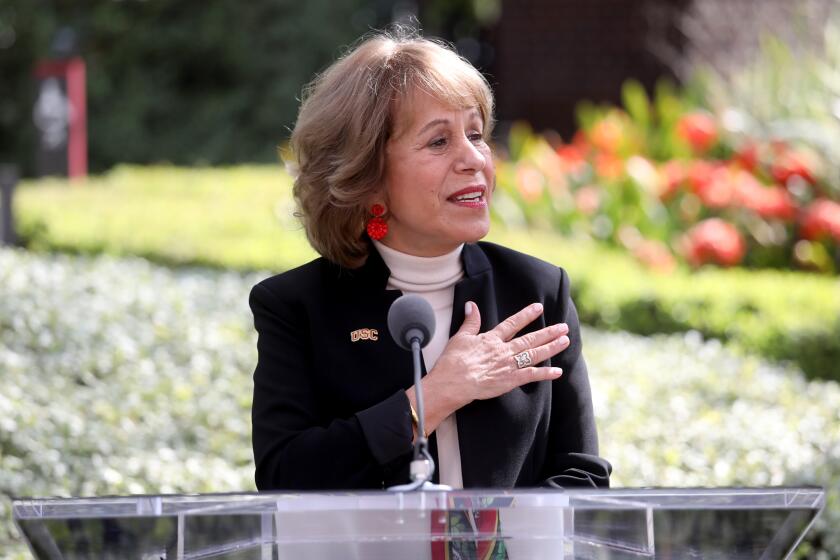S.F. Schools Consider Nonwhite Writer Quota
A proposal by two of the city’s school board members that more than half of the books high school students are required to read be by nonwhite authors has engulfed the district in a storm of criticism.
Board members Steve Phillips and Keith Jackson, who are African Americans, say that they want to ensure that the high school reading list reflects the makeup of racially and culturally diverse San Francisco, where only 13% of the students are white and the largest ethnic group is Chinese.
“What we are trying to do is provide the best writers from the culture of the students as a way to engage their attention in some sort of creative way,” Phillips said.
The proposal would mandate that four of the seven books students must read each year in class be by nonwhite authors. The seven-member board is scheduled to vote March 24. Phillips said he believes the plan will be adopted because four board members have expressed support.
But critics say that it would be wrong to put a quota on the number of nonwhite authors that students are mandated to read. Another board member, Juanita Owens, said she favors the initiative, but wants it expanded to require gay and lesbian authors.
The proposals seemed to bewilder some teachers and students.
“I didn’t know that books have a color,” said Lillie Morrisson, a ninth-grader at George Washington High School. “A book is a book. It doesn’t matter whom it is written by. It should be judged by how good it is and how it makes you feel.”
San Francisco Examiner columnist Rob Morse accused the school board of trying to “ethnically cleanse” what youngster are reading. “They’re complete idiots, and they’re in charge of your children,” he wrote in a column Wednesday.
Sheridan Blau, president of the National Council of Teachers of English, says he knows of no district in the United States that has established a percentage of nonwhite authors on its required reading list. Blau’s organization represents 100,000 English teachers. A spokesman for the Los Angeles Unified School District said that the district has for years included authors of various ethnic backgrounds on its reading lists, but has no quota.
“I applaud their desire to expand the canon and to have students read a wider range of authors,” Blau said. “But setting a quota in this fashion seems to me just what you get when you have people who are fundamentally politicians interfering with curriculum.”
Officials Cite Need to Weigh Many Factors
State officials also criticized the proposal.
State Supt. of Public Instruction Delaine Eastin believes that children should be exposed “to literature that is culturally and ethnically diverse,” said spokesman Doug Stone. “But to tie a required reading curriculum to a percentage of nonwhite or non-European authors is not a prudent approach. Books should be selected on a variety of factors, not simply ethnicity.”
State Board of Education President Yvonne Larson said she doesn’t think “that it is appropriate to select authors according to any criteria other than excellence in literature. It shouldn’t have to meet a standard of political correctness.”
Phillips said he knows from his experience as an African American student of literature at Stanford University that the standard readings that scholars are exposed to can be alienating for nonwhites.
“As I discovered more about the world, about racism and oppression and how those things work, studying ‘Clarissa’ and ‘Evelina’ [early British novels] seemed incredibly irrelevant and indulgent to me,” Phillips said. So he added African American studies to his major “and I became much more academically engaged.”
Phillips said he has no evidence beyond his experience and anecdotal accounts from parents and students to suggest that African American or Latino students who perform poorly in school or drop out do so because they are alienated by the curriculum.
“But the student population has dramatically changed over the past 20 years and we’re not succeeding as a public school system across this state and country with African American and Latino students,” Phillips said.
The school district has been inundated with phone calls, and listeners passionate on both sides have lit up radio talk show switchboards. Some callers said they favored anything that will get more students to read. Right-wing talk show host Rush Limbaugh scoffed at the proposal as another example of multiculturalism run amok.
National news organizations swooped down on classrooms Wednesday, interviewing teachers and students about the initiative. Bill Rojas, the San Francisco Unified School District’s superintendent, said he spent much of Wednesday doing damage control with outraged teachers opposed to a quota system.
A committee of teachers and parents has worked for two years on a new, expanded list of required readings for high school students, Rojas said. The district intends to adopt new requirements soon that students read 10 books from the new list each year.
Now, the district requires just three books: Chaucer’s “Canterbury Tales,” Shakespeare’s “Romeo and Juliet,” and Mark Twain’s “Huckleberry Finn,” and recommends that students read up to 10 books annually from a broad selection of authors.
The expanded list identifies each author by nationality or ethnicity. It includes Homer’s “The Odyssey,” along with Gabriel Garcia Marquez’s “Chronicle of a Death Foretold,” and several books by African, Chinese and other non-European authors.
“Shakespeare and Chaucer will be in and a whole lot of others will be in as well,” Rojas said. But the committee has not considered setting a quota for nonwhite authors, he said.
Change Is Overdue, Board Member Says
Rojas said he will be having many discussions with board members before they vote on Phillips’ and Jackson’s proposal. He said he will try to persuade them that it would be a mistake to set a percentage of nonwhite authors.
“I will not settle for an absolute quota number,” he said. “There is no magic number.”
Phillips said he is unperturbed by the outcry over the proposal. The time to revise the standard literature canon is long overdue, he added.
“To see this issue get so much attention is gratifying. I want to see if we can convene a national conference around a new curriculum for the 21st century,” Phillips said. “I want to elevate this out of the realm of ‘kooky San Francisco’ and show there is real intellectual merit to this discussion.”
But some teachers read the proposal as an assault on academic freedom and a vote of no-confidence in them and their students.
“It is not as though we haven’t talked about and cared about the issue of diversifying the curriculum for years,” said Danise Chandler, chairwoman of the English department at George Washington High School. “But to think that kids are dropping out of school because they aren’t reading enough black authors is just silly.
“Kids don’t connect with authors because they recognize the color of the author’s skin or the ethnicity of the author,” Chandler said. “They connect because the author says something that means something to them. ‘Romeo and Juliet’ becomes a lesson in morality. ‘Huckleberry Finn’ is about the nobility of the human spirit.”
The board members who have proposed the quota “just don’t trust these kids at all. Kids are much more imaginative and much more able to go beyond themselves than they give them credit for being,” Chandler said.
In some high school classrooms, arguments erupted among the students over the proposal.
Morrisson, the ninth-grader at George Washington, who is white, said the disputes divided uncomfortably along racial lines in her English literature class.
“I got in an argument with an African American girl,” she said. “I think the proposal is ridiculous. She said that ethnic authors understand what ethnic people are thinking and feeling.”
Times staff writer Hector Tobar contributed to this story.
More to Read
Start your day right
Sign up for Essential California for news, features and recommendations from the L.A. Times and beyond in your inbox six days a week.
You may occasionally receive promotional content from the Los Angeles Times.






